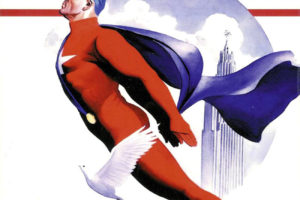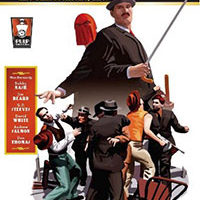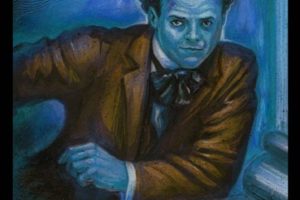
While many may not be familiar with the name Johnson McCulley, we probably know his most well-known character: Zorro. Zorro started off as a pulp character before moving to serials, movies, comics and more.
But what many may not be aware of are the many other serial characters (few as popular as Zorro, but a couple came close) that Johnston McCulley created. Some of these are currently available to pulp fans. Altus Press has reprinted a few of them, and I hope they do more. Wildside Press has reprinted some of the original collections.
From the Wikipedia article on McCulley, these are some of his other serial characters and their publication dates:
- The Black Star (1916-21, 1928, 1930)
- The Spider (1918-19)
- Thubway Tham (1918-60)
- The Thunderbolt (1920-21)
- The Man in Purple (1921)
- The Crimson Clown (1926-31, 1936, 1944)
- The Rollicking Rogue (1930)
- The Mongoose (1932-33)
- The Whirlwind (1933-35)
- The Green Ghost (1934-35)
- The Bat (1934-35)
Now, many of these I haven’t read (yet), so I can only go with what others have written. And there may be others that weren’t listed here.
Black Star is supposed to have been his second most popular character (though I wonder if that is really Thubway Tham?). He is one of the few villains that McCulley wrote, being a “gentleman burglar.” He (and his gang) does not kill, using vapor bombs and vapor guns to knock out their victims. He was popular enough that Street & Smith‘s Chelsea House imprint reprinted his stories in hardback. These have been reprinted by Wildside Press.
The Spider was another villain that McCulley created. He was injured as a youth and confined to a wheelchair, but he uses his intellect to be a criminal mastermind. He, too, had stories reprinted in hardback, which Wildside Press has reprinted.
Thu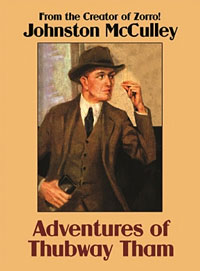 bway Tham (actually, the character is “Subway Sam,” but has a lisp and it comes out that way) was popular enough that McCulley was still writing stories about him into the ’50s! He’s a pickpocket who only works the New York Subways, and who only robs those who deserve it. Wildside Press has reprinted two of the original collections of his stories.
bway Tham (actually, the character is “Subway Sam,” but has a lisp and it comes out that way) was popular enough that McCulley was still writing stories about him into the ’50s! He’s a pickpocket who only works the New York Subways, and who only robs those who deserve it. Wildside Press has reprinted two of the original collections of his stories.
I have no idea about The Thunderbolt. I understand he’s a character with a sack-cloth mask with a lightning bolt on it.
The Man in Purple is another interesting, if short-lived character. Altus Press has reprinted the series. The MiP is really well off man-about-town Richard Staegel. He’s handsome and young and athletic, and engaged to Betty Hayler. But they both want thrills so decide to go into crime and steal from the rich, but only the rich who have gotten their wealth by ripping off “widows and orphans,” and so all their take is given to charity. So not so much a villain as a Robin Hood-type character. The MiP persona is created, which is Richard dressed in an all purple outfit, including a full face mask. To prevent any connection, Richard uses special purple material to make the outfits, and destroys them after using them so nothing can be traced back to him (an interesting idea of early forensic evidence). Assisting them is Broph, a down-and-out guy Richard rescues and recruits in the first story. Broph comes aboard as a chauffeur and assistant. Opposing them is Detective Troman.
The Crimson Clown was another popular character, and is similar to The Man in Purple. He is also a rich man-about-town, Delton Prouse, who uses the persona of the Crimson Clown to steal from the unjust rich and return the money to their victims (yup, another Robin Hood type). He uses a gas gun (something popular with several of McCulley’s characters). Chelsea House did two collections of stories, and Ramble House has reprinted them.
The Rollicking Rogue was a very short-lived character, all of two stories. Altus Press included him in their Green Ghost collection. The Rollicking Rogue is more in the vein of Zorro, with his alter ego being timid James Peters (probably not his real name). And the background is much more revenge-oriented then other characters, more in the line of the Count of Monte Cristo (or Judex or Alias Mr. Death).
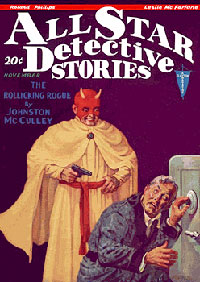 Whoever the Rogue is, he’s the son of a man ruined by a group of business men 10 years prior. His parents are long dead because of this, and he has slowly plotted revenge. His disguise as James Peters allows him access to his victims, and his timidness in this character throws off suspicion. His main foe is Detective Martin Shane, who works for his victims. The Rogue has prepared for this, planning and training, so is able to outwit him. Too bad it appears only two stories of him were done. Certainly things were setup for him to go after the others in the group. Who and how many were in the group were not specified, allowing for a more open-ended series, as opposed to the Alias Mr. Death series in which the group was clearly defined and each subsequent story takes care of one of the group. When the Rogue goes into action, he dresses in a colorful and outlandish outfit. This is seen in all its glory on the cover of his first appearance in All-Star Detective Stories (November 1930; shown at right).
Whoever the Rogue is, he’s the son of a man ruined by a group of business men 10 years prior. His parents are long dead because of this, and he has slowly plotted revenge. His disguise as James Peters allows him access to his victims, and his timidness in this character throws off suspicion. His main foe is Detective Martin Shane, who works for his victims. The Rogue has prepared for this, planning and training, so is able to outwit him. Too bad it appears only two stories of him were done. Certainly things were setup for him to go after the others in the group. Who and how many were in the group were not specified, allowing for a more open-ended series, as opposed to the Alias Mr. Death series in which the group was clearly defined and each subsequent story takes care of one of the group. When the Rogue goes into action, he dresses in a colorful and outlandish outfit. This is seen in all its glory on the cover of his first appearance in All-Star Detective Stories (November 1930; shown at right).
The Mongoose I have no info on.
The Whirlwind was a short-lived Zorro-like character. Altus Press reprinted the whole series. The Whirlwind is really a nameless Spanish noble who has left Spain (and his family wealth) over an argument with his father (what about, is never given). He arrives in the small village and take a new name and works for the local innkeeper. He tames the innkeeper’s horse in secret, and uses him in his escapades, which is to rob mean-hearted merchants and give to the poor. His main opponent is the local Sergeant. The innkeeper’s daughter seems to know who he really is, as does the local friar. But the number of characters are kept few, due to the shortness of the stories. Many of the rest of the stories deal more with other villains who are clearly evil, sometimes murdering others (something which The Whirlwind does not do) and committing crimes the Whirlwind is blamed for. The Whirlwind is motivated by thrill, rather than a sense of justice (as with Zorro).
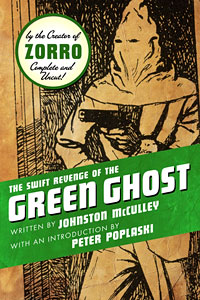 The Green Ghost (not to be confused with the later Green Ghost by G.T. Fleming-Roberts), is another short-lived character. Altus has reprinted the whole series. This Green Ghost ran for seven stories in 1934-35 in Thrilling Detective magazine. The Green Ghost is really former cop Danny Blaney, who puts on a green hood and gloves to fight crooks. We learn in the first story that Blaney was framed by crooks and lost his job as a cop. Though he fights crooks, he isn’t much for cops either, because they think he’s dirty.
The Green Ghost (not to be confused with the later Green Ghost by G.T. Fleming-Roberts), is another short-lived character. Altus has reprinted the whole series. This Green Ghost ran for seven stories in 1934-35 in Thrilling Detective magazine. The Green Ghost is really former cop Danny Blaney, who puts on a green hood and gloves to fight crooks. We learn in the first story that Blaney was framed by crooks and lost his job as a cop. Though he fights crooks, he isn’t much for cops either, because they think he’s dirty.
He battles a new crook in each story, and takes a portion of their loot. By day, Blaney runs a tobacco store. But clearing his name doesn’t seem to be part of the plot, and only in a few stories does he target those crooks who framed him. Each story is pretty short and enjoyable. There are almost no secondary characters, we see nothing of his personal life and don’t see much of his tobacco store except at the end of stories when he drops by. Otherwise, the stories are pretty much the Green Ghost going into action.
The Bat was another short-lived character in the model of his other characters, wearing a sack-cloth mask with a white bat on the forehead, and the common theme of an innocent man framed who strikes back at his enemies. And like other such characters, the Bat has a special gas gun. Like Popular Publications‘ The Spider (not the McCulley one), the Bat has a special ink stamp that he stamps on the forehead of the criminals he catches (but doesn’t kill), at least in the first story. The whole series was collected by Altus Press.
So hopefully people have a better appreciation of the works of Johnston McCulley. It is interesting some of the same themes pop up in his story. Several characters make a point of not killing, and a few of them have gas guns. A few characters use just a simple sack-cloth mask, sometimes with a mark on it. Several are Robin Hood-like characters. McCulley seems to fall back on a small set of common themes. Do check out these characters. All have something to interest the pulp reader.

